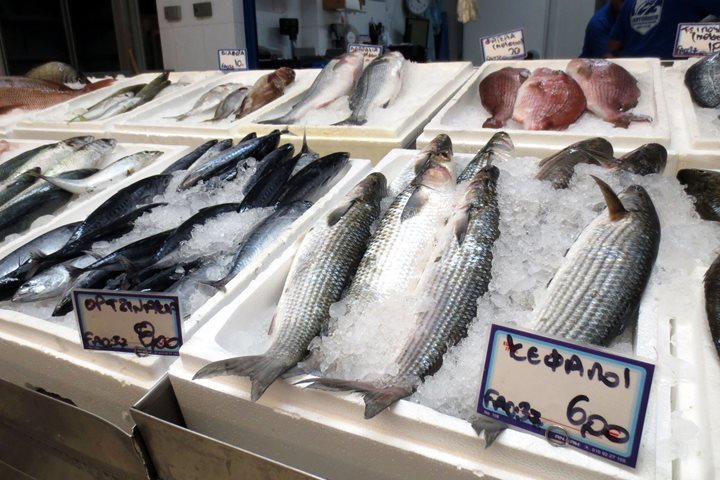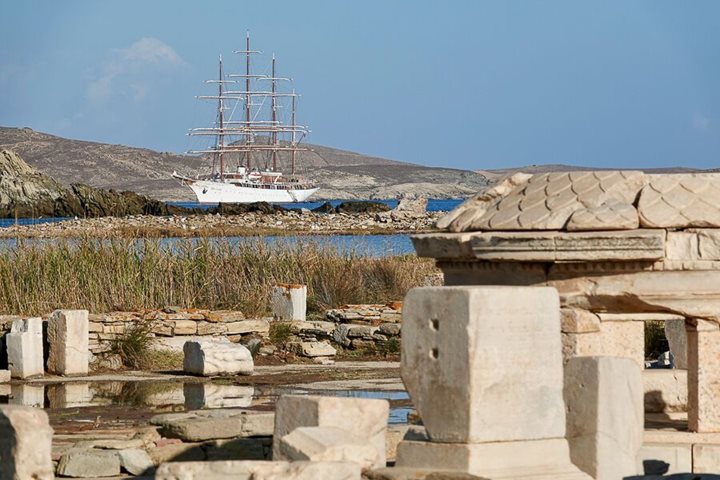Amorgos is one of the most stunning islands situated in the southeastern part of the Aegean, standing long, like a sharp arrow, signaling the direction to another group of islands, named the Dodecanese, it is a crossroad were the west meets the east. Amorgos belongs to what we name the small Cyclades, as they are the most remote and less inhabited ones. Amorgos was named after an endemic flax linum, famous in ancient times for the making of beautiful dresses.
By tender boat we reached the quaint harbor of Katapola, one of the deepest and most beautiful natural harbors of the Aegean. We soon began our exploring around the island by using the local bus. We meandered our way around sharp bends with breathtaking views of endless rows of terracing, long walls like lines drawn over the hillsides serving for retaining the earth, now and then goats, donkeys, chicken, and people working the dry and barren earth.
Soon we crossed over to the eastern part of the island where the scenery became even more dramatic, with precipitous limestone cliffs rolling down to the endless blue of the Aegean. Amorgos is cliff and sun, hardship and smile, storm and joviality… But where was the monastery, we could still not see it... and suddenly nesting at the foot of grim craggy towering cliffs, the dazzling white monastery gleams like a dragon’s egg. It is visible only from the sea, hanging like a white painting between the sea and the sky! It is dedicated to Panagia, the Virgin Mary and it is named Chozoviotisa, as the icon floated all the way from Chozova of Palestine to Amorgos, according to the tradition. The monastery dates to 1088 and it is a very important pilgrimage site up until this very day. The 300 steps are nothing and doesn’t stop visitors and us from climbing up to it.
In the church we saw the miraculous icon of the Virgin Mary, embellished with many ex-votes all around it, signs of miracles that once took place. We met two of the three monks of the monastery; they were very friendly even offering us a very special drink of the island named, “rakomelo.” This is a strong alcoholic drink distilled by the “rakos,” skins of grapes, mixed with honey and cinnamon. We also tried a typical Greek sweet called loukoumi that gave us back some energy after this long climb! We had to be especially careful when walking in the monastery as the actual structure is built into a cave.
Taken by the spirituality of the Monastery and the majestic scenery we continued to the “chora,” the main city of the island. This could not be seen from the sea, in order to be protected from the pirates. The cubic white houses, with the blue doors and windows, one next to the other, with narrow irregular alleys, one church and chapel succeeding the other, a number of old kafenia offering local specialties, artistic shops with all sorts of very unique mementos for us to take back with us.
What a wonderful visit it was; it became even more complete when we dived into the refreshing blue of the Aegean. We had another gorgeous lunch on board Sea Cloud, while it sailed away from Amorgos that had filled our eyes, mind and heart with wonderful feelings that we were going to keep forever!
In the afternoon Rebecca gave us a very interesting lecture about the history of the bronze age of Greece. After another special “afternoon tea” where Tom shared with us the history of Sea Cloud and incredibly interesting stories about this magnificent ship. The evening came to a perfect end with a sunset that we enjoyed from the island of Ios, where we anchored for the night.








